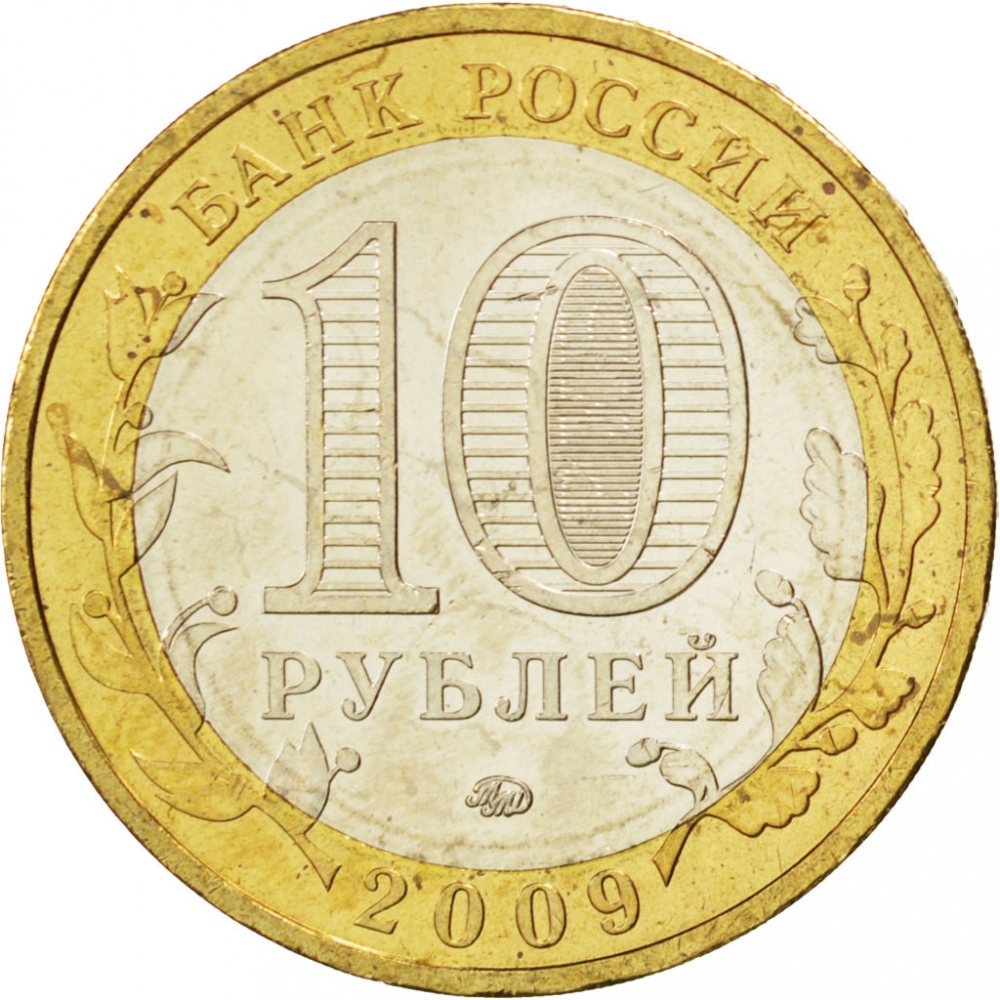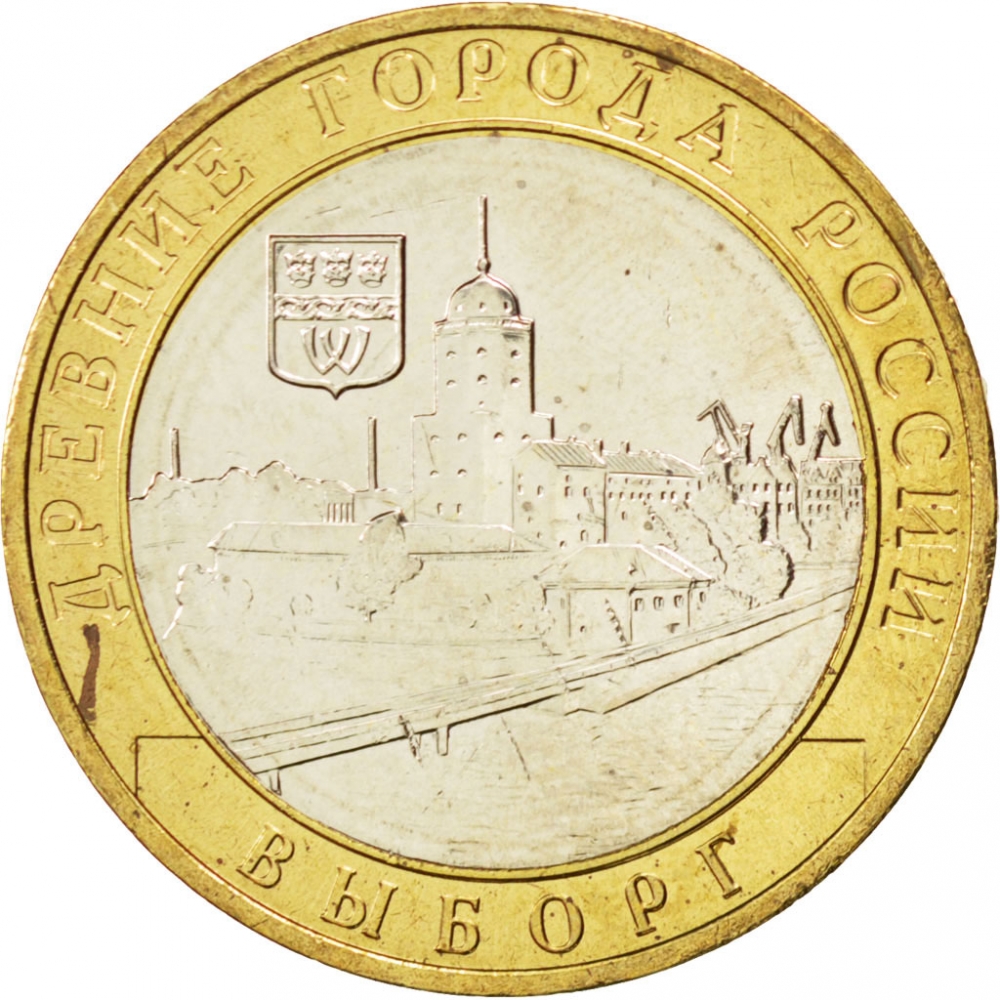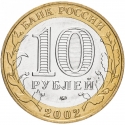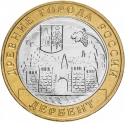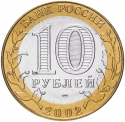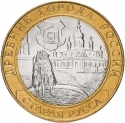You are about to finish your registration. Please check your mailbox (including spam folder). There should be a letter with a confirmation link. Check setting to make sure that your e-mail address is correct.
Send letter againDescription
In 2002 the Central Bank of the Russian Federation began an annual program that each year commemorates some of their historical towns on bi-metallic 10 Ruble coins. The coins picture the city and its arms on one side and has the standard Russian 10 Ruble obverse on the other. Unlike a lot of coin programs throughout the world there is no set regularity to the number of coins released each year in this series, with some years seeing 4 coins issued and other years only 3.
Vyborg (Finnish: Viipuri, Swedish: Viborg), a town and the administrative center of Vyborgsky District in Leningrad Oblast, Russia, lies on the Karelian Isthmus near the head of the Vyborg Bay, 130 km (81 miles) to the northwest of St. Petersburg and 38 km (24 miles) south of Russia's border with Finland, where the Saimaa Canal enters the Gulf of Finland.
The Viborg Castle was founded during the so-called "Third Swedish Crusade" in 1293 by marshal Torkel Knutsson on the site of older Karelian fort which was burned. The castle was fought over for decades between Sweden and the Novgorod Republic. Vyborg remained in Swedish hands until its capture in 1710 after the Siege of Vyborg by Tsar Peter the Great in the Great Northern War. One of the largest naval battles in history, the Battle of Vyborg Bay, was fought off the shore of the Vyborg Bay on July 4, 1790. After the rest of Finland was ceded to Russia in 1809, Emperor Alexander I incorporated the town and the governorate into the newly created Grand Duchy of Finland in 1811. Following the Russian Revolution of 1917 and the fall of the Russian Empire, Finland declared itself independent. During the Finnish Civil War, Vyborg was in the hands of the Finnish Red Guards until it was captured by the White Guard on the Battle of Vyborg, April 29, 1918. In the inter-war decades, the town,Viipuri, was the second biggest town in Finland and the seat of Viipuri Province.
The Winter War was concluded by the Moscow Peace Treaty, which stipulated the transfer of Vyborg and the whole Karelian Isthmus to Soviet control, where it was incorporated into the Karelo-Finnish Soviet Socialist Republic on March 31, 1940. On August 29, 1941, Vyborg was captured by Finnish troops. In December 1941, the Government of Finland formally annexed the town along with the other areas lost in the Moscow Peace Treaty. However, this annexation was not recognized by any foreign state, not even Finlands co-belligerent, Germany. The town fell to the Red Army on June 20, 1944, but the Finns managed to halt the Soviet offensive at the Battle of Tali-Ihantala—the largest battle fought by any of the Nordic countries—in Viipuri rural municipality which surrounded the town. The town was seriously damaged.
In the subsequent Moscow Armistice of September 19, 1944, Finland returned to the borders set by the Moscow Peace Treaty and ceded more land than the treaty originally demanded. In the 1947 Paris Peace treaties, Finland relinquished all claims to Viipuri/Vyborg.
Obverse

|
In the center of the disc indication of the denomination of the coin: 10 RUBLES, inside of the figure 0 hidden pictures of the number 10 and of the inscription RUB visible by turns on changing angle of vision, in the lower part of the disc the mint trade mark SPMD, on the ring along the rim above the inscription: BANK OF RUSSIA, below the year of issue 2009, to the left and to the right stylized twigs of plants going over to the disc. БАНК РОССИИ |
|---|---|
Reverse

|
Architectural panorama of the town, above the coat of arms of Vyborg, over it on a ribbon the semicircular inscription: ANCIENT TOWNS OF RUSSIA, below the inscription along the rim VYBORG. ДРЕВНИЕ ГОРОДА РОССИИ |
| Edge |
300 corrugations and the inscription ДЕСЯТЬ РУБЛЕЙ (TEN RUBLES) recurring twice and divided by asterisks. ДЕСЯТЬ РУБЛЕЙ ⋆ ДЕСЯТЬ РУБЛЕЙ ⋆ |
10 Rubles
Y# 983
Characteristics
| Type | Commemorative Issue (Circulating) |
| Material | Bi-Metallic |
| Ring | Brass |
| Center | Cupronickel |
| Weight | 8.4 g |
| Diameter | 27 mm |
| Thickness | 2.1 mm |
| Shape |
|
| Alignment | Medal |
| Mint |
Saint Petersburg Mint (SPMD)
|
